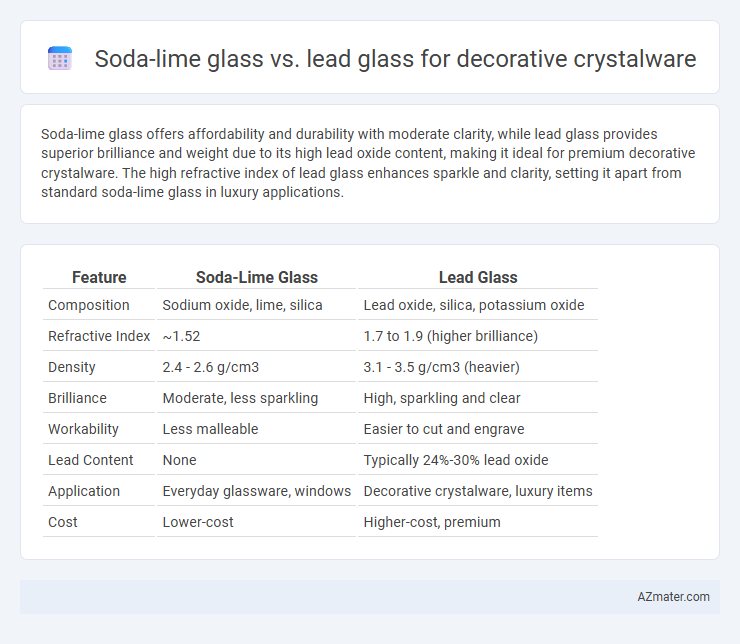Soda-lime glass offers affordability and durability with moderate clarity, while lead glass provides superior brilliance and weight due to its high lead oxide content, making it ideal for premium decorative crystalware. The high refractive index of lead glass enhances sparkle and clarity, setting it apart from standard soda-lime glass in luxury applications.
Table of Comparison
| Feature | Soda-Lime Glass | Lead Glass |
|---|---|---|
| Composition | Sodium oxide, lime, silica | Lead oxide, silica, potassium oxide |
| Refractive Index | ~1.52 | 1.7 to 1.9 (higher brilliance) |
| Density | 2.4 - 2.6 g/cm3 | 3.1 - 3.5 g/cm3 (heavier) |
| Brilliance | Moderate, less sparkling | High, sparkling and clear |
| Workability | Less malleable | Easier to cut and engrave |
| Lead Content | None | Typically 24%-30% lead oxide |
| Application | Everyday glassware, windows | Decorative crystalware, luxury items |
| Cost | Lower-cost | Higher-cost, premium |
Introduction to Decorative Crystalware Materials
Decorative crystalware is primarily crafted from soda-lime glass and lead glass, each offering distinct characteristics that influence design and durability. Soda-lime glass, composed mainly of silica, soda, and lime, provides affordability and versatility but lacks the brilliance and weight of lead glass. Lead glass, incorporating lead oxide, enhances refractive index and clarity, producing a sparkling brilliance and heavier feel that is highly prized in luxury crystalware.
Composition of Soda-Lime Glass
Soda-lime glass, primarily composed of about 70-75% silica (SiO2), 12-15% sodium oxide (Na2O) from soda ash, and 10-15% calcium oxide (CaO) from lime, offers durability and ease of manufacture for decorative crystalware. Unlike lead glass, which contains high lead oxide (PbO) content to increase weight and brilliance, soda-lime glass lacks the refractive properties that create the characteristic sparkle of lead crystal. Its chemical stability and lower production cost make soda-lime glass a practical choice for mass-produced decorative items but less suitable for high-end crystalware demanding enhanced clarity and light dispersion.
Composition of Lead Glass
Lead glass, also known as lead crystal, contains 18-40% lead oxide, which significantly increases its density, refractive index, and brilliance compared to soda-lime glass. Soda-lime glass primarily consists of silica, sodium oxide, and calcium oxide, resulting in a more common, less reflective material. The high lead oxide content in lead glass enhances its weight, clarity, and ability to be finely cut for decorative crystalware, making it preferred for luxury glass products.
Visual Clarity and Brilliance Comparison
Lead glass offers superior visual clarity and brilliance compared to soda-lime glass due to its higher refractive index and increased density, which enhance light dispersion and create a sparkling effect ideal for decorative crystalware. Soda-lime glass, while more affordable and durable, lacks the same level of brilliance and typically appears less clear and vivid under light. The lead content in lead glass amplifies its sparkle, making it the preferred choice for luxurious crystal pieces requiring exceptional optical performance.
Weight and Handling Differences
Soda-lime glass is lighter and more affordable, making it easier to handle for everyday decorative crystalware, while lead glass is denser due to its high lead oxide content, resulting in a heavier and more substantial feel often preferred for luxury items. The added weight of lead glass enhances its brilliance and clarity, but its increased mass requires more careful handling to avoid damage. Weight differences affect user experience and durability, with soda-lime glass offering a more practical option and lead glass providing elegance and visual appeal.
Sound and Resonance Attributes
Lead glass offers superior sound and resonance attributes for decorative crystalware due to its higher density and lead oxide content, producing a clear, long-lasting ring. Soda-lime glass, being less dense and lacking lead, creates a duller, shorter resonance with lower pitch. Crystalware crafted from lead glass is preferred for its enhanced tonal clarity and sustained vibration, elevating the sensory experience.
Durability and Scratch Resistance
Soda-lime glass offers moderate durability and scratch resistance, making it suitable for everyday decorative crystalware but prone to scratches over time. Lead glass, containing 24-30% lead oxide, provides enhanced hardness and superior scratch resistance, ensuring long-lasting brilliance and resilience in luxury crystal pieces. The higher density and refractive index of lead glass contribute to its durability, making it a preferred choice for high-end decorative items requiring both aesthetic appeal and durability.
Safety and Health Considerations
Soda-lime glass, commonly used for decorative crystalware, is safer and non-toxic as it contains no lead, minimizing health risks during handling and use. Lead glass, while prized for its clarity and brilliance, poses potential health hazards due to lead leaching, especially when in contact with acidic or hot substances. Choosing soda-lime glass significantly reduces exposure to harmful lead, ensuring safer decorative crystalware for everyday use.
Cost and Market Availability
Soda-lime glass is significantly more cost-effective and widely available in the market compared to lead glass, making it the preferred choice for budget-conscious decorative crystalware manufacturers. Lead glass offers superior clarity and brilliance but comes at a higher price point and is less commonly stocked due to regulatory concerns over lead content. Market availability of soda-lime glass is extensive, with numerous suppliers globally, while lead glass is more niche, often limited to specialized crystalware producers.
Choosing the Best Glass for Decorative Crystalware
Soda-lime glass offers durability and affordability, making it suitable for everyday decorative crystalware, while lead glass is prized for its superior clarity, brilliance, and weight, enhancing the elegance of luxury pieces. The high refractive index of lead glass creates a sparkling effect ideal for fine crystalware, though it is softer and more prone to scratching compared to soda-lime glass. Selecting the best glass depends on balancing cost, optical qualities, and usage, with lead glass favored for premium decorative items and soda-lime glass preferred for practical, budget-friendly options.

Infographic: Soda-lime glass vs Lead glass for Decorative crystalware
 azmater.com
azmater.com